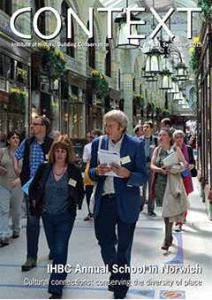
 Professor May Cassar, judge on the IHBC’s 2015 Student Award and Director of the UCL Institute for Sustainable Heritage, has selected as the winner of 2015 Gus Astley Student Award a dissertation entitled ‘EXPLORING THE VALUE OF HERITAGE: Urban exploration and the historic environment’, written by Samantha Stones, curator at English Heritage and previously a student under Harriet Devlin on the IHBC-recognised conservation course at the then Ironbridge Institute at the University of Birmingham.
Professor May Cassar, judge on the IHBC’s 2015 Student Award and Director of the UCL Institute for Sustainable Heritage, has selected as the winner of 2015 Gus Astley Student Award a dissertation entitled ‘EXPLORING THE VALUE OF HERITAGE: Urban exploration and the historic environment’, written by Samantha Stones, curator at English Heritage and previously a student under Harriet Devlin on the IHBC-recognised conservation course at the then Ironbridge Institute at the University of Birmingham.
The Gus Astley Trust also selected for commendation entries to the 2015 award by:
- Anna Shelley, for her work on ‘Anne of Denmark as an Architectural Patron, 1603-19’, developed on the IHBC-recognised Building History MSt at the University of Cambridge, led by Dr Adam Menuge IHBC
- Andrew McBride, for his work entitled ‘Amongst the Ruins of Slains Castle – Is there a Future for Scotland’s ‘Dracula Castle’?’, written on the ‘Architectural Studies with International Study’ programme at the University of Strathclyde, with Cristina Gonzalez-Longo as tutor
- Rob Ward, for his ‘Assessment of Large Drystone Structures on the Ffestiniog Railway’, written while on the ‘Structural Engineering with Architecture’ programme at the University of Edinburgh, with Tim Stratford as tutor.
All will receive cash prizes –£500 is awarded to Samantha, and £100 to the commended authors – and a free place at the IHBC’s Annual School in Worcester in June.
Details on all awarded submissions are offered below.
Gus Astley Award: Samantha Stones
Professor May Cassar said of Samantah’s selection: ‘The 2015 shortlist for the Gus Astley Student Award 2015 was as strong as it was varied and interesting. Its topics ranged from architectural conservation to energy efficiency, re-use of ruins, the lives of art patrons, building history and heritage engineering. All could have been worthy winners. However there can only be one winner and for me the most outstanding submission was the dissertation by Samantha Stones on ‘EXPLORING THE VALUE OF HERITAGE: Urban exploration and the historic environment.’
‘With her finger on the pulse of urban exploration of, and attitudes to, the historic environment, Samantha touches a theme that should make policy makers sit up and reflect.’
‘Samantha tells a story of contemporary alternative engagement with urban heritage which is both fascinating and an eye opener.’
Samantha Stones, Assistant Properties Curator (South) at English Heritage, said: ‘I am delighted and honoured to be the recipient of the 2015 Gus Astley Award.’
‘I chose to research urban exploration as a non-traditional approach to heritage and found surprising parallels in the language of exploration and the mainstream terminology of heritage values. Although urban exploration cannot be welcomed by the heritage community, there are interesting benefits to gaining an understanding of alternative and non-visible groups that are accessing and appreciating the built environment on their own terms.’
‘I’m extremely grateful to my colleagues at English Heritage for their support throughout my studies and career so far. In addition, particular thanks to Harriet Devlin for her sound guidance and encouragement throughout the Historic Environment Conservation course. Receiving the Gus Astley Award provides an exceptional end to a wonderful two years of study.
Tutor’s introduction to ‘…Urban exploration and the historic environment’
Samantha’s work is introduced as follows by her then tutor, Harriet Devlin MBE, now Course Leader on the IHBC-recognised ‘Conservation of the Historic Environment’ programme at Birmingham City University:
‘WHILE THE CITY SLEEPS THE NIGHT IS OURS. As night descends we creep out to explore the city and her secrets. We venture deep below into the sewers and the subways, dodging the trains which whistle by and jumping over the third rail. Nimbly we climb high above the streets, scaling the bridges, cranes and the rooftops, tiny specks unnoticed amongst the clouds. Welcome to sleepycity, where the urban infrastructure is our playground. Tell me more…’
This quote from Sleepycity.net is the opening of an extraordinary dissertation by Samantha Stones entitled ’Exploring the value of heritage.. Urban Exploration and the Historic Environment’.
Samantha, who works for English Heritage, was one of the last cohort of students from the Historic Environment Conservation postgraduate course at the Ironbridge Institute, and her choice of topic was edgy but important. Does ‘heritage’ alienate; should we embrace other interactions with heritage even if they are potentially illegal and dangerous? If we wish to encourage new and diverse audiences to heritage – is this a legitimate route?
To gather primary survey data for this study Samantha contacted over 200 individuals via online forums, social media sites, and offline professional and personal networks. In addition, in-depth interviews were carried out with urban explorers, heritage policymakers and owners. However, no practical fieldwork was undertaken! Sam did not abseil down a factory chimney or scale a wall topped with barbed wire. Sam’s conclusions are interesting:
Despite the mainstream media attention on place-hacking and infiltration, the study found that the core of urban exploration activity share many similarities with the perceived traditional heritage visit and the sectors wider outlook. Urban explorers research historic sites to understand the history and significance of a building and acknowledge all types of heritage values. The unregulated nature of urbex allows a freedom of movement and experience that encourages the individual to follow their own intuition and interests; from military history to asylums, or tall structures to underground bunkers. The necessity for visible decay to attract some urban explorers to a site reflects the assigned aesthetic value for abandonment, but also illustrates a broader appreciation for abandoned buildings as a culmination of historic layers with a still-changing presence. In contrast to the historic house museum, an abandoned building is not preserved or conserved to a strict time period and urban explorers can avoid the use of curators as intermediaries. The urban explorer is experiencing the building as a part of its history rather than witnessing the past from afar.
There are many barriers to the traditional heritage sector being able to embrace an activity that is unlawful, involves potentially high risks to personal safety and may be damaging to historic fabric. Alternative approaches to heritage, such as urban exploration, may not present the heritage sector with an easy route to a new audience, but can offer a new understanding of how groups wish to engage with the historic environment. To fully achieve audience diversification, the heritage sector must also embrace new technologies to ensure, not only that current online data is utilised, but that technologies can be optimised as gateways to heritage’
Neither condoning nor condemning, this study is an exciting exploration itself of an area many of us would be uncomfortable with and we are delighted that it has achieved recognition by IHBC through the Gus Astley Award.
Sam’s award is a great valedictory for the former course at the Ironbridge Institute – but the course continues under a different name as Conservation of the Historic Environment within the School of Architecture at Birmingham City University. Let’s hope this fosters equal original thinking!’
Gus Astley Awards 2015: Commendations
The following submissions were selected for commendation on behalf of the Gus Astley Trust. All receive cash awards of £100 and free places at the IHBC’s 2016 Annual School in Worcester.
Anna Shelley, author of ‘Anne of Denmark as an Architectural Patron, 1603-19’, said: ‘I am really thrilled to be awarded a Commendation for the Gus Astley award, and it is very gratifying to receive wider recognition for this piece of work. I am most grateful too to my dissertation supervisor, Professor Deborah Howard, whose guidance and support was invaluable.’
‘My thesis explored themes within the architectural patronage of Anne of Denmark, Queen consort of James I, between 1603-19, their years in London. Although Anne’s buildings and landscapes are for the most part lost, details of the commissioned works are well-documented in the records of the Office of Works and elsewhere. Above all, the project has shown me the value of looking again at well-worn material to reveal a fresh story and to gain new insights into early seventeenth-century architectural trends and practices.’
‘The IHBC marries my academic and professional interests, so it will be a pleasure to attend the Annual School in June!’
Anna’s tutor Adam Menuge IHBC said: ‘In the week that IHBC announced its recognition of the MSt in Building History this is a particularly welcome bonus for us. Anna Shelley’s commended work exemplifies the research qualities on which all good evidence-based conservation depends. She has an excellent career ahead of her.’
Andrew McBride, author of ‘Amongst the Ruins of Slains Castle – Is there a Future for Scotland’s ‘Dracula Castle’?’, said: ‘I am honoured that my dissertation has been chosen for commendation and to be offered a place at the IHBC annual school. It was very interesting to research and enjoyable to write the dissertation on Slain’s castle, since it’s one of my favorite ruins in Scotland!
Andrew’s tutor Cristina Gonzalez-Longo said: ‘This is an outstanding work, providing an excellent discussion on the conservation of ruins and the implications in its conservation, focusing on Slains Castle, a victim of the roof tax avoidance.’
‘It considers different theories and a variety of examples (national and international), reflecting on how creative architectural projects could help in the conservation of ruins. It combines an excellent understanding of the topic, the use of carefully selected resources and examples as well as original analytical work.’
Rob Ward, author of ‘Assessment of Large Drystone Structures on the Ffestiniog Railway’, said: ‘This project was a perfect combination of my interest in historic buildings, my specialism – structural engineering and my love of drystone walls. Maybe not seen as an exciting topic by many, this project proved that they are far from dull.’
‘I hope that this work is continued by future students at the University of Edinburgh in collaboration with the Ffestiniog Railway in order to assist in their asset care programme and in order to support this important historic feature of industry and tourism in North Wales.’
‘I’d also like to say ‘thank you’ to the IHBC for considering my work worthy of a commendation and I look forward to attending the annual summer school.’
For more on the annual IHBC Gus Astley Student Award
NB: Awards close on 31 July each year, but cover work submitted on any UK taught course during the previous two years.
For background to the Student Awards, and to submit
 The IHBC has responded to the recent NPPF review, highlighting the needs of historic towns and cities, and championing the needs of the historic environment including archaeological issues affecting housebuilding.
The IHBC has responded to the recent NPPF review, highlighting the needs of historic towns and cities, and championing the needs of the historic environment including archaeological issues affecting housebuilding.


